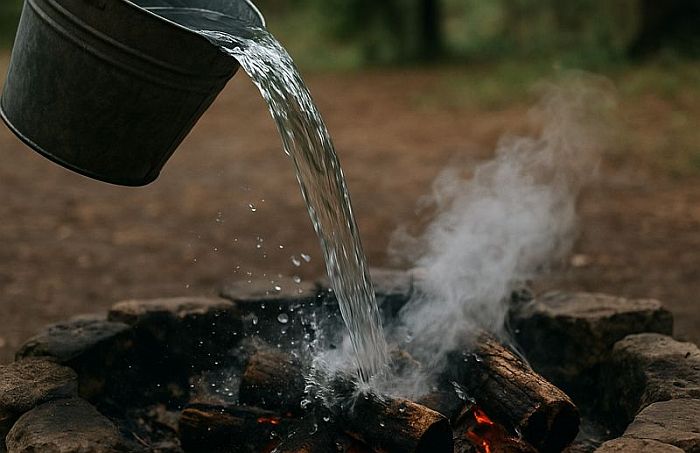A campfire is fun and all, but the second you’re done roasting marshmallows and solving the world’s problems, that fire becomes your responsibility. A single hot coal can survive overnight, roll away, and light up an entire forest like a bad news headline.
This page may contain affiliate links; you can read our full disclosure.
Putting out a fire the right way isn’t optional — it’s part of being a grown-up in the outdoors.
This is how to do it properly, with zero guesswork, zero nonsense, and zero “I thought it was out” fires.
Why Campfires Stay Hot Longer Than You Think
Here’s the thing most beginners don’t understand: campfires don’t go out just because the flames stop.
Coals stay hot for hours — sometimes well into the next day. Even buried embers can reignite with a little oxygen or a gust of wind.
If you can’t safely touch the ashes with your bare hand (don’t actually do it), the fire isn’t out.
Step 1: Let the Fire Burn Down Naturally
Before you start dumping water like a panicked fireman:
- Stop adding fuel 20–30 minutes before shutting down
- Let flames die into glowing coals
- Spread logs out so they cool faster
You’re not trying to smother a raging bonfire — you’re putting out a mostly-dead fire correctly.
Step 2: Pour Water — Slowly and Directly
Forget the cowboy movie splash from ten feet away. You want water on the embers, not the general area.
- Pour water slowly and steadily onto the coals
- Listen for hissing — that’s heat being killed
- Stir the ashes with a shovel or stick
- Add more water
- Stir again
If it’s not soupy and cold, you’re not done.
What NOT to do:
- Don’t pee on it
- Don’t dump drinks or cooking grease on it
- Don’t assume “it looks out” means anything
Step 3: Stir, Drown, Stir Again
Water alone won’t always reach hidden embers. Stirring exposes hot pockets that can reignite later.
- Add water
- Stir
- Add more water
- Repeat until cold
If steam is still coming off it, it’s not out.
Step 4: Use Dirt Only If You Know What You’re Doing
Dirt is a last resort, not your primary tool. Dirt can insulate heat instead of killing it.
- Mix dirt aggressively with coals
- Break apart clumps
- Make sure no heat is trapped underneath
Water beats dirt every time.
Step 5: Verify It’s Out
Here’s the rule experienced campers live by:
If it’s not cool enough to touch, your fire is NOT out.
Hover your hand over the pit:
- No heat
- No steam
- No smoke smell
- No glowing embers
If you feel warmth, repeat the process.
Step 6: Spread the Ashes Before You Leave
Once everything is cold:
- Spread wet ashes around the fire ring
- Break apart large chunks
- Remove anything that could smolder
This prevents heat pockets and speeds cooling.
Special Cases: How to Put Out…
Smoker Logs / Fatwood Coals
These burn hot and long. Use extra water and stir more than usual.
Windy Conditions
Embers travel. Put fires out earlier and check downwind for strays.
Fire Bans / Dry Seasons
If conditions are unsafe, fires shouldn’t be burning at all.
Common Dumb Mistakes (Don’t Be This Person)
- Leaving while coals are still warm
- Piling rocks on a fire
- Throwing sand like it solves everything
- Assuming rain will finish the job
- Going to bed with “it should be fine” confidence
Do it right once, and you never have to guess.
Conclusion
Putting out a campfire safely isn’t complicated — it just takes patience.
Drown it. Stir it. Drown it again. Make sure it’s cold.
If everyone did this correctly, a lot fewer wildfires would exist.

